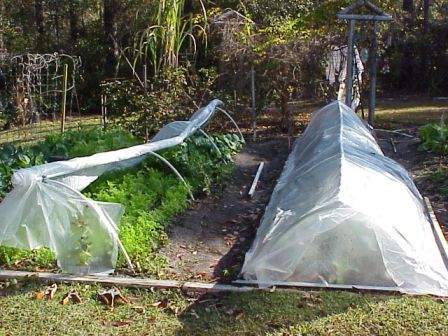
by Eddie Powell | Nov 17, 2014
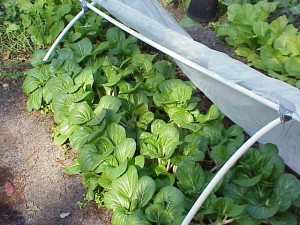
Northwest Florida homeowners enjoy growing their own vegetables every fall, but are faced with cold weather issues, especially during the first few days of December. For example, most cole crops can be planted until November, but they must be protected from the cold weather or they will need to be replaced. A good variety of cold tolerant plants should be used in order to prevent total devastation of the garden by extremely cold weather.
Below are a few tips to assist the home gardener in growing a successful winter vegetable crop.
- For tender plants, site selection should the top priority when preparing for a freeze. Vegetable plants need a site with good air drainage; not in a low area where cold air settles. Arranging tender plants along a barrier to protect them from cold winds improves the plants cold protection, especially from very hard freezes.
- Poorly drained soils result in weak and shallow roots which are more susceptible to cold injury.
- Plants grown with the correctly applied rate of nutrients will tolerate colder temperatures better and recover from cold injury faster than plants grown with little to no nutrients.
- Watering vegetable garden plants before a freeze can help protect plants. A well watered soil will absorb more solar radiation than dry soil and will radiate heat during the night. This may increase cold tolerance by as much as 2°F.
- Saturated soil conditions can damage the root systems of most plants over a few days, so make sure the ground is well-drained.
- Healthy vegetable plants are more resistant to cold than vegetable plants weakened by disease, insect damage, or nematode damage. Routine inspection for pests and implementation of necessary control measures are essential.
- Plastic or cloth coverings can help protect vegetable plants more from frost than from extreme cold. Covers that extend to the ground and are not in contact with the vegetable plants foliage will reduce cold injury. If the vegetable plant foliage is in contact with the cover it is often cold burned or injured because of heat transfer from the foliage to the colder cover. Some examples of excellent plant covers are cloth sheets, quilts or black plastic. If plastic covering is used, it is extremely important to remove the covering during the day to provide for ventilation of trapped heat.
- Feel free to contact your local county extension office for information on cold protection, pest identification and recommended control measures.
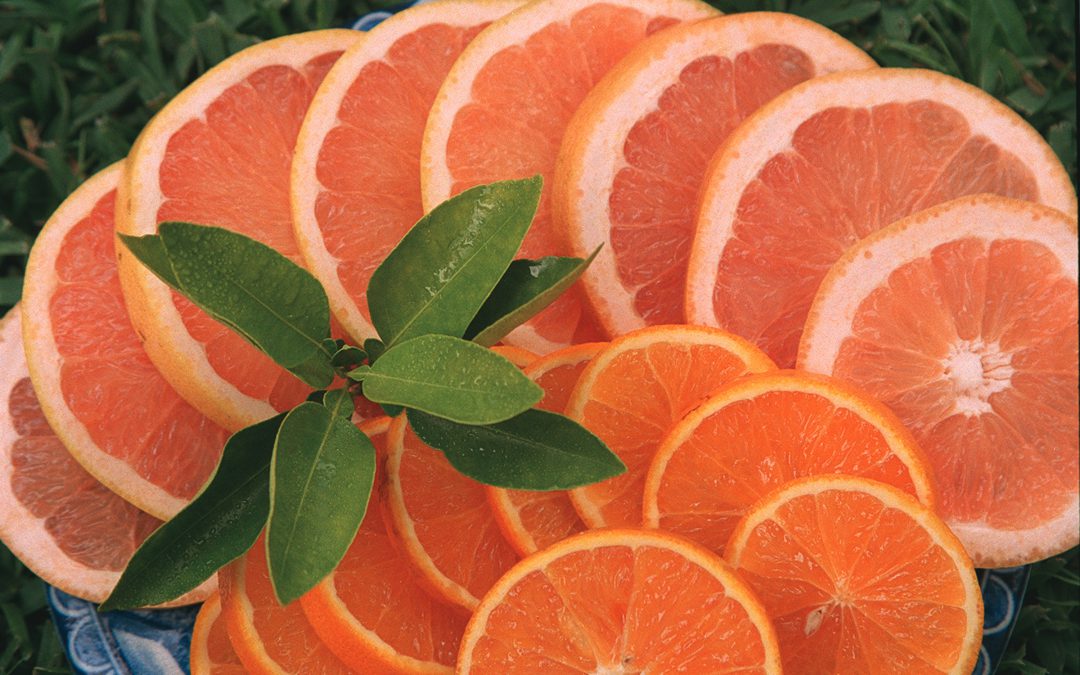
by Matthew Orwat | Nov 17, 2014
Tuesday November 19th and Wednesday November 20th, substantial freezing weather is expected
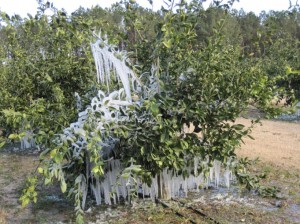
How cold does it have to get before citrus in Northwest Florida needs to be protected? A concrete answer to this question does not exist. Growers and home gardeners alike must consider several factors including type of citrus grown and the location of the citrus.
Below are a few quick facts to assist growers and home gardeners in determining whether to protect or not to protect their citrus:
- Certain citrus trees such as lime, pomelo, grapefruit, sweet orange, lemon and citron will definitely need protection or need to be moved into a sheltered area. Individuals that grow these types on a consistent basis either wrap their trees with protective covers each season or grow them in containers and move them into greenhouses.
- The meyer lemon, which is in reality a lemon-sweet orange hybrid, is a tree that was introduced to the united states in 1908. Mature dormant meyer lemons can be hardy down to 20°F, with fruit hardy to 26°F. Immature trees, or those that have not reached dormancy, should be protected. Covers made of cloth should be large enough to touch the ground so that heat from the soil can help keep the tree warm.
- Generally, satsuma are cold tolerant down to 15° F, but young trees or trees yet to achieve dormancy are usually only tolerant to 26°F. Fruit should not sustain damage from freezing temperatures above 25°F. Extreme winds sometimes make the effects of freeze events worse, so it is always better to err on the side of protection if the trees are planted in an exposed site.
- Kumquats are the most cold tolerant citrus type grown in Northwest Florida, so protection is not required unless freeze events reach 20°F.
Additional facts to assist the grower or home gardener with citrus protection:
- Plant trees on a south-facing slope, south of windbreaks, on the south side of a structure or under a light canopy if possible. South facing slopes block harmful cold winds. Structures offer radiant heat which aids in the protection of citrus trees. Additionally, light over-story pine canopies allow sufficient sunlight through while reducing frost damage.
- Wrap the trunk with commercial tree wrap or mound soil around the base of the tree up to 2 feet. This will protect the graft of the young tree. Thus, if the branches freeze the graft union will be protected.
- Cover the tree with a cloth sheet or blanket. For additional protection, large bulb Christmas lights can be placed around the branches of the tree. This will increase the temperature under the cover by several degrees. Be sure to use outdoor lights and outdoor extension cords to avoid the potential of fire.
- Water citrus trees. Well watered trees have increased cold hardiness. Do not over-water. If the ground is moist, it is not necessary to water.
- Frames may be installed around young trees to hold the cover. This option keeps the blanket or sheet from weighing down the branches.
- For large production areas, micro-irrigation is an option. This practice will protect citrus trees up to 5 feet, but must be running throughout the entire freeze event. For additional information read this publication on micro-sprinkler irrigation.
- Always remember to remove cold protection once the temperature rises so that the trees do not overheat.
- Do not cover trees with plastic tarp, these will not protect the tree and can “cook” the tree once the sun comes out.
For additional information, contact your local extension office.
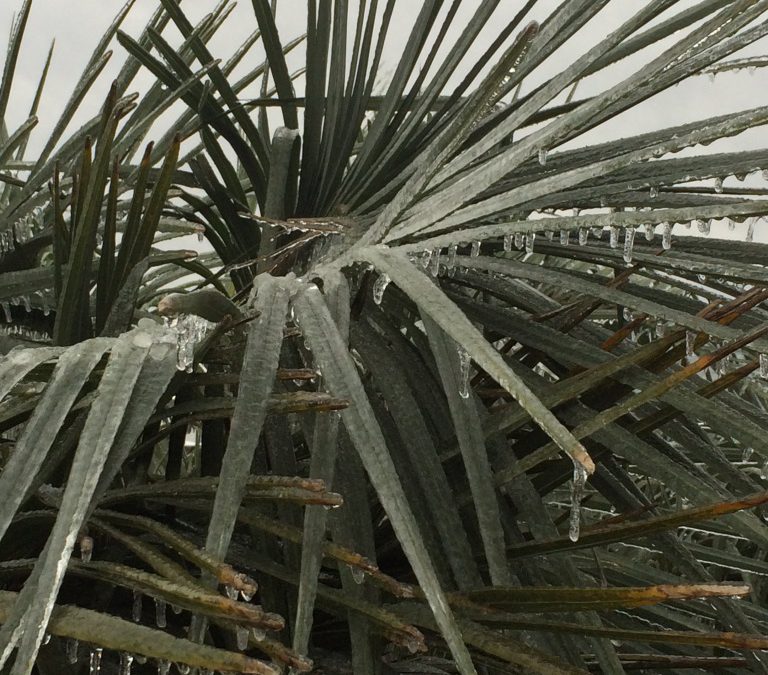
by Mary Salinas | Feb 4, 2014
The freezing rain last week across the panhandle left icicles hanging from street signs, rooftops, trees, shrubs and palms. Many people now wonder if their palms will survive the assault of the hard freeze. The chance of survival depends on the following factors:
- the most important consideration is the species of palm; a few of the most cold tolerant that are more readily available are pindo palm, mule palm, European fan palm, Chinese fan palm, needle palm, cabbage palm, and dwarf palmetto
- whether the palm is in an area protected by other vegetation or buildings
- proper fertilization with 8-2-12-4 has been followed
- palms have been properly pruned, i.e. only dead fronds have been removed from the crown (overtrimming by removing green fronds is a stress to the palm)
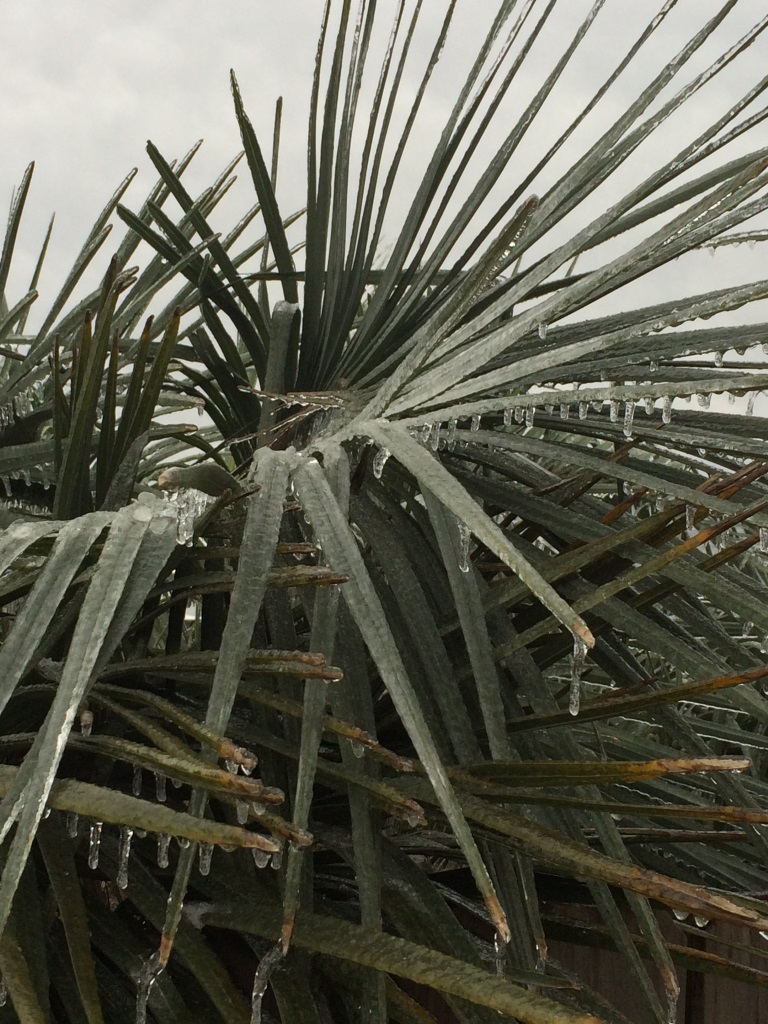
Icy pindo palm. Photo by Mary Derrick UF IFAS.
The best approach is to leave the palm alone until all danger of frost or freeze is past. Avoid the temptation to remove any of the dead fronds; they will help insulate and protect the meristem, or bud, that will produce new shoots.
If the palm is not too tall, in the spring check to see if the spear leaf (the newest frond that usually stands straight up and has not opened) can be easily pulled out. If the spear leaf does not pull out, the likelihood that the palm has survived is good. Don’t despair if the spear leaf does pull out as the meristem below it may still survive. The best strategy in that event is to remove the dead spear leaf and treat the bud area below the spear leaf with a copper fungicide to reduce the chance of infection of the bud. Be sure to use a copper fungicide and not a copper fertilizer, like copper sulfate.
Once spring comes and you find that the palms have survived, don’t be alarmed if the first new frond is deformed or has dead tips. The fronds that follow will most likely be normal. The palm will be building its depleted food reserves with new leaves so do not remove any fronds that have any green on them whatsoever. All green tissue is making food for the palm and helping it to recover from the cold stress. Only remove fronds that have completely died and have no green tissue.
When temperatures warm and the palms are actively growing, apply a palm fertilizer with the formulation of 8-2-12-4 with micronutrients.
For more information please see the following University of Florida IFAS publications:
Palms for North Florida
Cold Damage on Palms
Fertilization of Field-grown and Landscape Palms in Florida
Pruning Palms
by Taylor Vandiver | Dec 24, 2013

Garden Tools. Photo courtesy: UF/IFAS Gardening Solutions
Due to a lack of snow, Florida’s winter landscape chores are relatively uncomplicated. However, that doesn’t mean they’re unimportant. As the growing season comes to a close and gardeners mow, snip and spade for the final time, it’s time to consider proper cleaning and storage of all that equipment. A little preventative maintenance can avoid frustration and expensive repair in the future. When tools are maintained properly their life is extended substantially and their work efficiency is increased. A few examples of preventative care include cleaning and sanitizing, sharpening blades, and maintaining power equipment.
When cleaning tools, remove caked on soil or vegetation using a wire brush, scraper or a strong stream of water. Sharpen hoes, pruners, loppers and saws.
Always remember to check tools thoroughly for loose screws or nuts and tighten them accordingly. Spraying the bare metal parts and cutting edges of tools with a penetrating oil, such as WD-40, will help prevent rust. It is thought that wiping tools’ wooden handles with boiled linseed oil will help prevent wood from cracking and drying.
Another item to consider while preparing one’s landscape for the winter is the garden hose. While hoses don’t need a great deal of care, a few small steps are important if they are to last. Store hoses on hose supports or reels or coil them loosely rather than hanging them on nails. Using hose supports or reels prevents the hose from sagging and kinking. Drain all the water and store in a dry location before storing hoses away for the winter.
Power equipment, such as lawn mowers, may require additional winter preparations. Always refer to the owner’s manual for specific information. However, in general, the following steps can be taken to winterize this equipment.
Remove collected grease, dirt and plant material from the equipment. It is always beneficial to check for loose screws and nuts and tighten them accordingly. Remember to sharpen cutting edges. If equipment has a four-cycle engine, change the oil by following instructions listed in the owner’s manual. Remove all gasoline from tank. It’s good to run the engine a turn or two to coat the cylinder walls with oil, and then replace the plug.
Two-cycle engines, or engines that run with a gas and oil mixture, also should have the oil-gas mixture removed for the winter. Run the engine with the choke open to remove fuel from the lines. Check the spark plug and replace if it is worn. Replace other worn or damaged parts as well. Always avoid storing gasoline over the winter. Old gasoline does not ignite easily, making the machines using it work harder.
Once the cold weather creeps in to Florida, gardeners may feel as if they can sit back and wait for spring, however, don’t neglect proper maintenance of garden tools. When the weather warms up, properly working garden equipment will be the gardens’ best asset!
For more information feel free to contact your local Extension Office.
by Matthew Orwat | Nov 18, 2013
On the night of November 13th, a mild freeze of 30°F occured in parts of Northwest Florida. Don’t be caught without a citrus protection plan !

Satsuma Tree protected with micro-irrigation. Image Credit: UF IFAS Jackson County Extension
How cold does it have to get before citrus in Northwest Florida needs to be protected? A concrete answer to this question does not exist. Growers and home gardeners alike must consider several factors including type of citrus grown and the location of the citrus.
Below are a few quick facts to assist growers and home gardeners in determining whether to protect or not to protect their citrus:
- Certain citrus trees such as lime, pomelo, grapefruit, sweet orange, lemon and citron will definitely need protection or need to be moved into a sheltered area. Individuals that grow these types on a consistent basis either wrap their trees with protective covers each season or grow them in containers and move them into greenhouses.
- The meyer lemon, which is in reality a lemon-sweet orange hybrid, is a tree that was introduced to the united states in 1908. Mature dormant meyer lemons can be hardy down to 20°F, with fruit hardy to 26°F. Immature trees, or those that have not reached dormancy, should be protected. Covers made of cloth should be large enough to touch the ground so that heat from the soil can help keep the tree warm.
- Generally, satsuma are cold tolerant down to 15° F, but young trees or trees yet to achieve dormancy are usually only tolerant to 26°F. Fruit should not sustain damage from freezing temperatures above 25°F. Extreme winds sometimes make the effects of freeze events worse, so it is always better to err on the side of protection if the trees are planted in an exposed site.
- Kumquats are the most cold tolerant citrus type grown in Northwest Florida, so protection is not required unless freeze events reach 20°F.
Additional facts to assist the grower or home gardener with citrus protection:
- Plant trees on a south-facing slope, south of windbreaks, on the south side of a structure or under a light canopy if possible. South facing slopes block harmful cold winds. Structures offer radiant heat which aids in the protection of citrus trees. Additionally, light over-story pine canopies allow sufficient sunlight through while reducing frost damage.
- Wrap the trunk with commercial tree wrap or mound soil around the base of the tree up to 2 feet. This will protect the graft of the young tree. Thus, if the branches freeze the graft union will be protected.
- Cover the tree with a cloth sheet or blanket. For additional protection, large bulb Christmas lights can be placed around the branches of the tree. This will increase the temperature under the cover by several degrees. Be sure to use outdoor lights and outdoor extension cords to avoid the potential of fire.
- Water citrus trees. Well watered trees have increased cold hardiness. Do not over-water. If the ground is moist, it is not necessary to water.
- Frames may be installed around young trees to hold the cover. This option keeps the blanket or sheet from weighing down the branches.
- For large production areas, micro-irrigation is an option. This practice will protect citrus trees up to 5 feet, but must be running throughout the entire freeze event. For additional information read this publication on micro-sprinkler irrigation.
- Always remember to remove cold protection once the temperature rises so that the trees do not overheat.
- Do not cover trees with plastic tarp, these will not protect the tree and can “cook” the tree once the sun comes out.
For additional information, contact your local extension office.
by Eddie Powell | Nov 18, 2013

Image Credit : Eddie Powell
Northwest Florida homeowners enjoy growing their own vegetables every fall, but are faced with cold weather issues, especially during the first few days of December. For example, most cole crops can be planted until November, but they must be protected from the cold weather or they will need to be replaced. A good variety of cold tolerant plants should be used in order to prevent total devastation of the garden by extremely cold weather.
Below are a few tips to assist the home gardener in growing a successful winter vegetable crop.
- For tender plants, site selection should the top priority when preparing for a freeze. Vegetable plants need a site with good air drainage; not in a low area where cold air settles. Arranging tender plants along a barrier to protect them from cold winds improves the plants cold protection, especially from very hard freezes.
- Poorly drained soils result in weak and shallow roots which are more susceptible to cold injury.
- Plants grown with the correctly applied rate of nutrients will tolerate colder temperatures better and recover from cold injury faster than plants grown with little to no nutrients.
- Watering vegetable garden plants before a freeze can help protect plants. A well watered soil will absorb more solar radiation than dry soil and will radiate heat during the night. This may increase cold tolerance by as much as 2°F.
- Saturated soil conditions can damage the root systems of most plants over a few days, so make sure the ground is well-drained.
- Healthy vegetable plants are more resistant to cold than vegetable plants weakened by disease, insect damage, or nematode damage. Routine inspection for pests and implementation of necessary control measures are essential.
- Plastic or cloth coverings can help protect vegetable plants more from frost than from extreme cold. Covers that extend to the ground and are not in contact with the vegetable plants foliage will reduce cold injury. If the vegetable plant foliage is in contact with the cover it is often cold burned or injured because of heat transfer from the foliage to the colder cover. Some examples of excellent plant covers are cloth sheets, quilts or black plastic. If plastic covering is used, it is extremely important to remove the covering during the day to provide for ventilation of trapped heat.
- Feel free to contact your local county extension office for information on cold protection, pest identification and recommended control measures.







